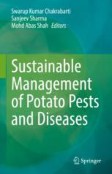Search
Search Results
-
Biology and Management of Aphids Infesting Potato
Aphids are the most important pests of potato worldwide. They are sap-feeding insects, but the major damage inflicted by aphids in potato crops is by...
-
Are fungal epizootics a sign of successful biological control of cereal aphids?
Pandora neoaphidis is a common entomopathogenic fungus on Sitobion avenae , which is an important aphid pest on cereals in Europe. Pandora neoaphidis ...

-
Species Composition and Distribution of the Vector Aphids of PVY and PLRV in India
Aphid transmitted viruses are the most significant constraint for quality seed potato production. Potato virus Y and Potato leaf roll virus are the...

-
A Recipe for Success: Three Key Strategies Used by Aphids and Pseudomonas syringae to Colonize the Phyllosphere
Aphids and Pseudomonas syringae are a permanent challenge for agriculture, causing severe losses to the crop industry worldwide. Despite the obvious...

-
Supplemental LED lighting improves plant growth without impeding biological control of aphids with parasitoids in a tri-trophic greenhouse system
Artificial lighting, including light-emitting diode (LED) illumination, is increasingly being optimized in protected agricultural systems to maximize...

-
Different nest entrance architecture by Colobopsis and Temnothorax ants colonizing oak galls
Galls are neoformed structures induced on the tissues of a host plant by different organisms, mostly insects. Apart from the inducers, galls can also...

-
Incidence of the cabbage aphid, Brevicoryne brassicae L. in potato crops in India and its efficiency for transmission of potato virus Yo
Potato crops are infected by a large number of aphid-transmitted viruses resulting in yield loss and degeneration of seed stocks. These viruses are...

-
Transmission of Viruses by Aphids
The majority of plant-infecting viruses are transmitted to their host plants by different species of aphid vectors. Aphids are efficient virus...
-
Nectar shortage caused by aphids may reduce seed output via pollination interference
Herbivores decrease plant fitness by consuming reproductive tissues, limiting resources, and/or affecting mutualisms. Although these mechanisms were...

-
A host range survey of the M strain of plum pox virus in native Asteraceae weeds in Japanese apricot orchards and a possible infection cycle
Plum pox virus (PPV, genus Potyvirus ) is one of the most economically important plant viruses. The PPV M strain (PPV-M) was first isolated in Japan...

-
Reciprocal influence of soil, phyllosphere, and aphid microbiomes
BackgroundThe effect of soil on the plant microbiome is well-studied. However, less is known about the impact of the soil microbiome in multitrophic...

-
Studies to identify an alternative aphid host for culturing the predatory syrphid, Ischiodon scutellaris (Fabricius) (Diptera: Syrphidae)
BackgroundAphidophagous syrphid, Ischiodon scutellaris (Fabricius) (Diptera: Syrphidae) is an effective predator of aphids that infest many...

-
Arbuscular Mycorrhizal Fungi Under Intercrop, Regenerative, and Conventional Agriculture Systems
Arbuscular mycorrhizal fungi (AMF) increase in diversity and abundance in agricultural systems that emphasize soil health practices, including...
-
Sap-Sucking Forest Pests
Sap-sucker insects are distinguished by their specialized mouthparts, adapted to penetrate and suck fluids from plant tissues. Many sap-sucking...
-
Exploration of phyllosphere microbiomes in wheat varieties with differing aphid resistance
BackgroundLeaf-associated microbes play an important role in plant development and response to exogenous stress. Insect herbivores are known to alter...

-
Herbivore-induced plant volatiles, not natural enemies, mediate a positive indirect interaction between insect herbivores
Many insect herbivores engage in apparent competition whereby two species interact through shared natural enemies. Upon insect attack, plants release...

-
After spring, after crops: which alternative hosts for the generalist parasitoid Diaeretiella rapae (Hymenoptera: Braconidae)?
Generalist aphid parasitoids seem to behave as specialists at the local scale. The temporal pattern of host exploitation by parasitoids is key to...

-
Population dynamics of Melanaphis sacchari (Zehntner), the aphid vector of sugarcane yellow leaf virus under tropical conditions in India
Sugarcane yellow leaf disease (YLD) has emerged as a serious threat to sugarcane cultivation worldwide, particularly in India. The aphid, Melanaphis...

-
Fitness costs of the cultivable symbiont Serratia symbiotica and its phenotypic consequences to aphids in presence of environmental stressors
Associations between symbiotic microorganisms and animals are ubiquitous and hosts may benefit from hosting microbial communities through enhanced...

-
Can biological control be a strategy to control vector-borne plant viruses?
Plant viruses transmitted by vector pests are one of the most important worldwide threats to global food production and security. Biological control...

